Pedestrian Crossing Environments in an Emerging Chinese City: Vehicle Encountering, Seamless Walking, and Sensory Perception Perspectives
Abstract
1. Introduction
2. Walkability and the Evaluation of Pedestrian Crossings: A review
3. Contextual Background: Suzhou
4. Three Indices
5. Data Collection
6. Results
6.1. Overall Performance
6.2. VE Index
(Group Sizeij) + β5j × (Femaleij) + β6j × (Red Lightij) + rij
6.3. CT Index
(Group Sizeij) + β5j × (Femaleij) + β6j × (Red Lightij) + β7j × (VEij) + rij
6.4. H Index
6.5. Traffic Signal Effects
7. Conclusions
Author Contributions
Funding
Acknowledgments
Conflicts of Interest
Appendix A. Summary of the Sample Pedestrian Crossings and the Location Map
| Place A: Renai | Place B: Linquan | Place C: Time Square | ||
| Shape |  | 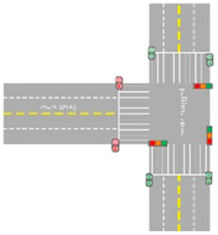 | 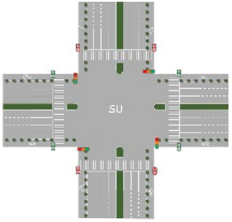 | |
| Image | 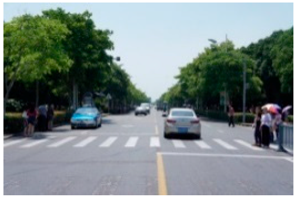 |  | 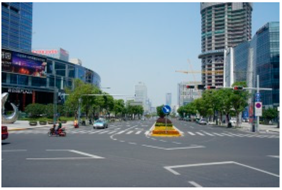 | |
| Width (m) | 19.5 | 22.5 | 36 | |
| VE index | 2.47 | 0.46 | 0.61 | |
| CT index | 1.25 | 1.05 | 1.14 | |
| H index | 7.1 | 3.9 | 4.2 | |
| Max. H index | 11.3 | 6.3 | 9.6 | |
| Pedestrian volumes (per min) | 5.9 | 9.5 | 4.5 | |
| Vehicle volumes (per min) | 19.3 | 10.2 | 14.5 | |
| Green light (%) | No traffic signal | 67.1% | 41.4% | |
| Half Green light (%) | 19.8% | 47.3% | ||
| Red (%) | 13.1% | 11.3% | ||
| N (sample pedestrians) | 405 | 879 | 522 | |
| Note | Between universities and retail shops | Surrounded by residential buildings | An urban sub-centre surrounded by office buildings and retail shops | |
| Place D: Dadiyuezhang | Place E: Primary school | Place F: Shishan road (SND) | Summary | |
| Shape | 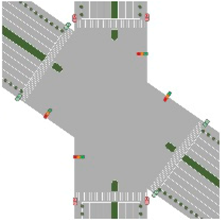 | 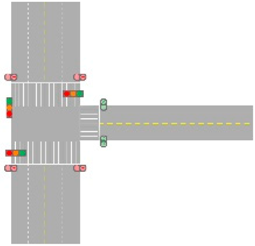 |  | |
| Image | 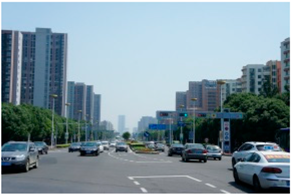 | 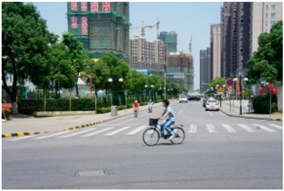 | 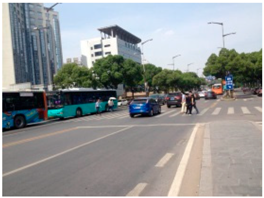 | |
| Width (m) | 19.5 | 19.5 | 19.5 | 19.5 |
| VE index | 0.86 | 0.32 | 5.60 | 1.16 |
| CT index | 1.88 | 1.22 | 1.71 | 1.19 |
| H index | 4.9 | 4.1 | 6.6 | 5.8 |
| Max. H index | 7.5 | 7.8 | 12.2 | 12.2 |
| Pedestrian volumes (per min) | 0.6 | 1.1 | 3.9 | 4.3 |
| Vehicle volumes (per min) | 30.1 | 9.9 | 40.2 | 25.5 |
| Green light (%) | 2.5% | 55.1% | No traffic signal | 54.5% |
| Half Green light (%) | 88.9% | 29.6% | 32.9% | |
| Red (%) | 8.6% | 15.3% | 12.6% | |
| N (sample pedestrians) | 81 | 176 | 125 | 2241 |
| Note | Interchange with irregular shape surrounded by residential buildings | A residential area near a primary school | An arterial road surrounded by office and residential buildings | |
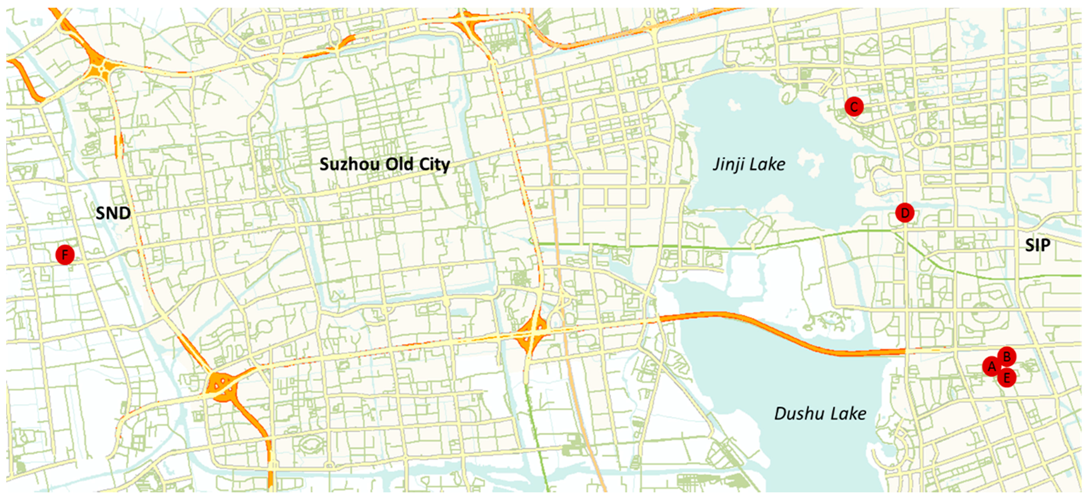 | ||||
Appendix B. Descriptive Statistics of Level 1 Variables
| N | Minimum | Maximum | Mean | S.D. | |
|---|---|---|---|---|---|
| VE | 2188 | 0 | 26 | 1.16 | 2.500 |
| CI | 2188 | 0.2000 | 5.1724 | 1.192447 | 0.5150749 |
| Traffic Volume | 2188 | 35 | 570 | 158.24 | 91.224 |
| Children | 2188 | 0 | 1 | 0.03 | 0.172 |
| Pedestrians with special needs | 2188 | 0 | 1 | 0.02 | 0.140 |
| In red light | 2188 | 0 | 1 | 0.10 | 0.293 |
| Female | 2188 | 0 | 1 | 0.21 | 0.407 |
| Group size | 2188 | 1 | 28 | 1.79 | 1.220 |
References
- World Health Organization (WHO). Global Status Report on Road Safety; World Health Organization: Geneva, Switzerland, 2015. [Google Scholar]
- Naci, H.; Chisholm, D.; Baker, T.D. Distribution of road traffic deaths by road user group: A global comparison. Inj. Prev. 2009, 15, 55–59. [Google Scholar] [CrossRef] [PubMed]
- King, M.J.; Soole, D.; Ghafourian, A. Illegal pedestrian crossing at signalised intersections: Incidence and relative risk. Accid. Anal. Prev. 2009, 41, 485–490. [Google Scholar] [CrossRef] [PubMed]
- Lassarre, S.; Papadimitriou, E.; Yannis, G.; Golias, J. Measuring accident risk exposure for pedestrians in different micro-environments. Accid. Anal. Prev. 2007, 39, 1226–1238. [Google Scholar] [CrossRef] [PubMed]
- Sarkar, S. Evaluation of safety for pedestrians at macro-and microlevels in urban areas. Transp. Res. Rec. 1995, 1502, 105. [Google Scholar]
- Vasconcellos, E.A. Equity evaluation of urban transport. In Urban Transport in the Developing World: A Handbook of Policy and Practice; Dimitriou, H.T., Gakenheimer, R., Eds.; Edward Elgar Publishing: Northampton, MA, USA, 2011. [Google Scholar]
- Kim, H.M.; Cocks, M. The role of Quality of Place factors in expatriate international relocation decisions: A case study of Suzhou, a globally-focused Chinese city. Geoforum 2017, 81, 1–10. [Google Scholar] [CrossRef]
- Kim, H.M. The influx of high-income foreign nationals and the housing market in a developing country: A case study of Suzhou Industrial Park, China. J. Hous. Built Environ. 2018, in press. [Google Scholar] [CrossRef]
- Kim, H.M. A profile of foreign nationals in a globalising second-tier Chinese city, Suzhou. In Geopolitics and Strategic Management in the Global Economy; Presenza, A., Sheehan, L., Eds.; IGI Global: Hershey, PA, USA, 2018; pp. 295–314. [Google Scholar] [CrossRef]
- Kim, H.M.; Cocks, M. Urbanisation and Globalisation: An Overview of Modern Suzhou Development. In Healthy Future Cities; Han, S.S., Lin, W., Eds.; China Architecture Industry Press: Beijing, China, 2018; pp. 379–395. [Google Scholar]
- Southworth, M. Designing the walkable city. J. Urban Plan. Dev. 2005, 131, 246–257. [Google Scholar] [CrossRef]
- Forsyth, A. What is a walkable place? The walkability debate in urban design. Urban Des. Int. 2015, 20, 274–292. [Google Scholar] [CrossRef]
- Royal, D.; Miller-Steiger, D. National Survey of Bicyclist and Pedestrian Attitudes and Behavior. Volume II: Findings Report. No. HS-810 972; U.S. Department of Transportation: Washington, DC, USA, 2008.
- McMillan, T.E.; Cubbin, C.; Parmenter, B.; Medina, A.V.; Lee, R.E. Neighborhood sampling: How many streets must an auditor walk? Int. J. Behav. Nutr. Phys. Act. 2010, 7, 20–25. [Google Scholar] [CrossRef] [PubMed]
- Du, P.; Wood, A.; Ditchman, N.; Stephens, B. Life Satisfaction of Downtown High-Rise vs. Suburban Low-Rise Living: A Chicago Case Study. Sustainability 2017, 9, 1052. [Google Scholar] [CrossRef]
- Speck, J. Walkable City: How Downtown Can Save America, One Step at a Time; Farrar, Straus and Giroux: New York, NY, USA, 2012. [Google Scholar]
- Kelly, C.E.; Tight, M.R.; Hodgson, F.C.; Page, M.W. A comparison of three methods for assessing the walkability of the pedestrian environment. J. Transp. Geogr. 2011, 19, 1500–1508. [Google Scholar] [CrossRef]
- Waizman, G.; Shoval, S.; Benenson, I. Micro-simulation model for assessing the risk of vehicle–pedestrian road accidents. J. Intell. Transp. Syst. 2015, 19, 63–77. [Google Scholar] [CrossRef]
- Cho, G.-H.; Rodriguez, D. Location or design? Associations between neighbourhood location, built environment and walking. Urban Stud. 2015, 52, 1434–1453. [Google Scholar] [CrossRef]
- Cerin, E.; Leslie, E.; Owen, N.; Bauman, A. An Australian version of the neighborhood environment walkability scale: Validity evidence. Meas. Phys. Educ. Exerc. Sci. 2008, 12, 31–51. [Google Scholar] [CrossRef]
- Muraleetharan, T.; Adachi, T.; Hagiwara, T.; Kagaya, S. Method to determine pedestrian level-of-service for crosswalks at urban intersections. J. East. Asia Soc. Transp. Stud. 2005, 6, 127–136. [Google Scholar]
- Guo, H.; Wang, W.; Guo, W.; Jiang, X.; Bubb, H. Reliability analysis of pedestrian safety crossing in urban traffic environment. Saf. Sci. 2012, 50, 968–973. [Google Scholar] [CrossRef]
- Poudel-Tandukar, K.; Nakahara, S.; Ichikawa, M.; Poudel, K.C.; Jimba, M. Risk perception, road behavior, and pedestrian injury among adolescent students in Kathmandu, Nepal. Inj. Prev. 2007, 13, 258–263. [Google Scholar] [CrossRef] [PubMed]
- Granié, M.-A. Effects of gender, sex-stereotype conformity, age and internalization on risk-taking among adolescent pedestrians. Saf. Sci. 2009, 47, 1277–1283. [Google Scholar] [CrossRef]
- Hutchinson, T.P.; Kloeden, C.N.; Lindsay, V. Countermeasures to the problem of accidents to intoxicated pedestrians. J. Forensic Leg. Med. 2010, 17, 115–119. [Google Scholar] [CrossRef] [PubMed]
- Stavrinos, D.; Byington, K.W.; Schwebel, D.C. Distracted walking: Cell phones increase injury risk for college pedestrians. J. Saf. Res. 2011, 42, 101–107. [Google Scholar] [CrossRef] [PubMed]
- Morrongiello, B.A.; Barton, B.K. Child pedestrian safety: Parental supervision, modeling behaviors, and beliefs about child pedestrian competence. Accid. Anal. Prev. 2009, 41, 1040–1046. [Google Scholar] [CrossRef] [PubMed]
- Gandhi, T.; Trivedi, M.M. Pedestrian protection systems: Issues, survey, and challenges. IEEE Trans. Intell. Transp. Syst. 2007, 8, 413–430. [Google Scholar] [CrossRef]
- Hall, P.G. Cities of Tomorrow: An Intellectual History of Urban Planning and Design in the Twentieth Century, 3rd ed.; Blackwell Publishers: Oxford, UK; Malden, MA, USA, 2002. [Google Scholar]
- Ishaque, M.M.; Noland, R.B. Making roads safe for pedestrians or keeping them out of the way? J. Transp. Hist. 2006, 27, 115–137. [Google Scholar] [CrossRef]
- Dayaratne, R. Towards trasnforming Colombo to a ‘walkable’ city: Policies and strategies. Built-Environ. Sri Lanka 2011, 9–10, 2–13. [Google Scholar] [CrossRef]
- Mahmoudi, M.; Ahmad, F.; Abbasi, B. Livable streets: The effects of physical problems on the quality and livability of Kuala Lumpur streets. Cities 2014, 43, 104–114. [Google Scholar] [CrossRef]
- Harrell, W.A. Factors influencing pedestrian cautiousness in crossing streets. J. Soc. Psychol. 1991, 131, 367–372. [Google Scholar] [CrossRef]
- Koh, P.P.; Wong, Y.D.; Chandrasekar, P. Safety evaluation of pedestrian behaviour and violations at signalised pedestrian crossings. Saf. Sci. 2014, 70, 143–152. [Google Scholar] [CrossRef]
- Dias, I.; Dissanayake, S. Characteristics of red-light-running crashes and evaluation of retro-reflective signal backplates in preventing red-light-running violations. Adv. Transp. Stud. 2014, 19–32. [Google Scholar] [CrossRef]
- O’Flaherty, C.A. Transport Planning and Traffic Engineering; Arnold: London, UK, 1997. [Google Scholar]
- Kim, H.M. The role of foreign firms in China’s urban transformation: A case study of Suzhou. In Population Mobility, Urban Planning and Management in China; Wong, T.-C., Han, S.S., Zhang, H., Eds.; Springer: London, UK, 2015; pp. 127–143. [Google Scholar]
- Yang, Y.R.; Hsia, C.J. Spatial clustering and organizational dynamics of transborder production networks: A case study of Taiwanese information-technology companies in the Greater Suzhou Area, China. Environ. Plan. A 2007, 39, 1346–1363. [Google Scholar] [CrossRef]
- Pereira, A.A. The Suzhou Industrial Park Experiment: The case of China-Singapore governmental collaboration. J. Contemp. China 2004, 13, 173–193. [Google Scholar] [CrossRef]
- Pereira, A.A. State Collaboration and Development Strategies in China: The Case of the China-Singapore Suzhou Industrial Park; RouteledgeCurzon: London, UK; New York, NY, USA, 2003. [Google Scholar]
- Rouphail, N.; Hummer, J.; Allen, P.; Milazzo, J. Recommended Procedures for Chapter 13, Pedestrians, of the Highway Capacity Manual; FHWA-RD-98-107; Federal Highway Administration, US Department of Transportation: Washington, DC, USA, 1998.
- Liu, Y.-C.; Tung, Y.-C. Risk analysis of pedestrians’ road-crossing decisions: Effects of age, time gap, time of day, and vehicle speed. Saf. Sci. 2014, 63, 77–82. [Google Scholar] [CrossRef]
- Rosenbloom, T. Crossing at a red light: Behaviour of individuals and groups. Transp. Res. Part F 2009, 12, 389–394. [Google Scholar] [CrossRef]
- Sisiopiku, V.P.; Akin, D. Pedestrian behaviors at and perceptions towards various pedestrian facilities: An examination based on observation and survey data. Transp. Res. Part F 2003, 6, 249–274. [Google Scholar] [CrossRef]
- Tabibi, Z.; Pfeffer, K. Choosing a safe place to cross the road: The relationship between attention and identification of safe and dangerous road-crossing sites. Child Care Health Dev. 2003, 29, 237–244. [Google Scholar] [CrossRef] [PubMed]
- Hine, J. Pedestrian travel experiences: Assessing the impact of traffic on behaviour and perceptions of safety using an in-depth interview technique. J. Transp. Geogr. 1996, 4, 179–199. [Google Scholar] [CrossRef]
- Ishaque, M.M.; Noland, R.B. Behavioural issues in pedestrian speed choice and street crossing behaviour: A review. Transp. Rev. 2008, 28, 61–85. [Google Scholar] [CrossRef]
- Agarwal, S.; Swami, B.L. Road traffic noise, annoyance and community health survey—A case study for an Indian city. Noise Health 2011, 13, 272. [Google Scholar] [CrossRef] [PubMed]
- Mateo-Babiano, I. Pedestrian’s needs matter: Examining Manila’s walking environment. Transp. Policy 2016, 45, 107–115. [Google Scholar] [CrossRef]
- Leyden, K.M. Social capital and the built environments: The importance of walkable neighborhoods. Am. J. Public Health 2003, 93, 1546–1551. [Google Scholar] [CrossRef] [PubMed]
- Henderson, J. Street Fight: The Politics of Mobility in San Francisco; University of Massachusetts Press: Amherst, MA, USA, 2013. [Google Scholar]


| Fixed Effect | Coefficient | Standard Error | t-Ratio | p-Value | |
|---|---|---|---|---|---|
| Level 2 | Intercept, γ00 | 3.9000 | 2.056 | 1.897 | 0.154 |
| Presence of Traffic Signal *, γ01 | −3.506 | 1.211 | −2.895 | 0.063 | |
| Width, γ02 | 0.003 | 0.094 | 0.029 | 0.978 | |
| Level 1 | Traffic volume, β1 | 0.006 | 0.001 | 5.181 | <0.001 |
| Children *, β2 | −0.232 | 0.251 | −0.925 | 0.355 | |
| Pedestrians with special needs *, β3 | −0.221 | 0.323 | −0.683 | 0.494 | |
| Group size, β4 | 0.055 | 0.039 | 1.397 | 0.163 | |
| Female *, β5 | 0.294 | 0.102 | 2.895 | 0.004 | |
| In red light *, β6 | 0.374 | 0.157 | 2.389 | 0.017 | |
| Fixed Effect | Coefficient | Standard Error | t-Ratio | p-Value | |
|---|---|---|---|---|---|
| Level 2 | Intercept, γ00 | 29.730 | 29.846 | 0.996 | 0.393 |
| Presence of Traffic Signal *, γ01 | 6.904 | 17.539 | 0.394 | 0.720 | |
| Width, γ02 | −0.321 | 17.539 | 0.394 | 0.720 | |
| Level 1 | Traffic volume, β1 | −0.003 | 0.004 | −0.870 | 0.385 |
| Children *, β2 | 1.171 | 0.910 | 1.288 | 0.198 | |
| Pedestrians with special needs *, β3 | 3.030 | 1.173 | 2.584 | 0.010 | |
| Group size, β4 | 0.585 | 0.143 | 4.093 | <0.001 | |
| Female *, β5 | 0.129 | 0.370 | 0.349 | 0.727 | |
| In red light *, β6 | −2.569 | 0.569 | −4.513 | <0.001 | |
| VE, β7 | 2.224 | 0.078 | 28.579 | <0.001 | |
| Model | Coefficients | SE | Standardised Coefficients | T | Significance |
|---|---|---|---|---|---|
| (Constant) | 33.981 | 5.660 | 6.004 | 0.000 | |
| Num. of vehicles | 0.099 | 0.011 | 0.588 | 8.789 | 0.000 |
| Num. of pedestrians | 0.136 | 0.041 | 0.172 | 3.327 | 0.001 |
| Presence of Traffic Signal * | −12.753 | 3.994 | −0.216 | −3.193 | 0.002 |
| VE Index | CT Index | |
|---|---|---|
| Green light | 0.37 | 1.11 |
| Partial green light | 0.62 | 1.23 |
| Red light | 0.83 | 1.03 |
© 2018 by the authors. Licensee MDPI, Basel, Switzerland. This article is an open access article distributed under the terms and conditions of the Creative Commons Attribution (CC BY) license (http://creativecommons.org/licenses/by/4.0/).
Share and Cite
Kim, H.M.; Mateo-Babiano, I. Pedestrian Crossing Environments in an Emerging Chinese City: Vehicle Encountering, Seamless Walking, and Sensory Perception Perspectives. Sustainability 2018, 10, 2200. https://doi.org/10.3390/su10072200
Kim HM, Mateo-Babiano I. Pedestrian Crossing Environments in an Emerging Chinese City: Vehicle Encountering, Seamless Walking, and Sensory Perception Perspectives. Sustainability. 2018; 10(7):2200. https://doi.org/10.3390/su10072200
Chicago/Turabian StyleKim, Hyung Min, and Iderlina Mateo-Babiano. 2018. "Pedestrian Crossing Environments in an Emerging Chinese City: Vehicle Encountering, Seamless Walking, and Sensory Perception Perspectives" Sustainability 10, no. 7: 2200. https://doi.org/10.3390/su10072200
APA StyleKim, H. M., & Mateo-Babiano, I. (2018). Pedestrian Crossing Environments in an Emerging Chinese City: Vehicle Encountering, Seamless Walking, and Sensory Perception Perspectives. Sustainability, 10(7), 2200. https://doi.org/10.3390/su10072200





